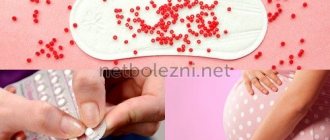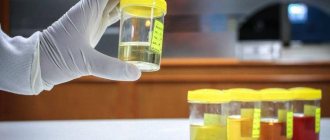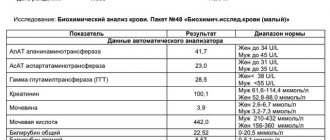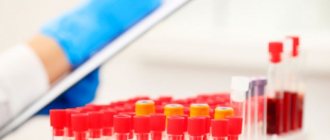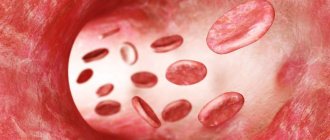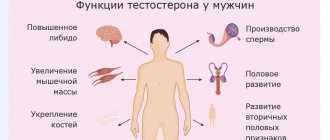In this article you can not only evaluate your blood test, but also get answers to the following questions:
. | … |
Detailed description of the study
Bilirubin is a reddish-yellow pigment formed from hemoglobin. Total bilirubin is a combination of direct and indirect fractions of this pigment.
Indirect - unbound, free - bilirubin is formed from destroyed red blood cells. It is poorly soluble in water and is toxic to the body, especially when its permissible concentration in serum is exceeded. Normally, indirect bilirubin joins albumin - serum proteins - in the blood and is transported to the liver, where it is converted into direct (bound, non-free). This process is associated with a conjugation reaction - a molecule of glucuronic acid is added to free bilirubin.
The direct fraction of bilirubin is soluble in water and is not toxic to the body. Direct bilirubin enters the lumen of the small intestine along with bile, where it is divided into two parts. The first part of the pigment is absorbed into the blood and excreted from the body along with urine in the form of urobilin pigment. The second part, during biochemical reactions under the influence of enzymes of the intestinal microbiota, is converted into the pigment stercobilin, which is excreted along with feces.
Many diseases are characterized by a syndrome of increased total bilirubin in the blood, or hyperbilirubinemia. This condition is potentially dangerous due to the fact that bilirubin is toxic to the organs of the central nervous system: the brain and spinal cord.
The main clinical symptom of a pronounced increase in the concentration of bilirubin in the blood is jaundice. It is characterized by skin changes from lemon yellow, orange yellow to greenish. Jaundice is a nonspecific syndrome; its development can be caused by many diseases. In clinical practice, there are three types of jaundice:
- Hemolytic, or suprahepatic;
- Parenchymal, or hepatic;
- Mechanical, or subhepatic.
Prehepatic jaundice develops against the background of hemolysis - destruction - of red blood cells, which leads to the release of a large volume of indirect bilirubin into the bloodstream.
Hepatic jaundice is associated directly with damage to liver cells. This type of jaundice occurs with hepatitis of various origins: viral, autoimmune, medicinal, toxic, etc.
Subhepatic jaundice is associated with a violation of the outflow of bile from the liver along the bile ducts. This variant of jaundice is associated with cholelithiasis and pathologies of the pancreas, including tumors. This type of jaundice usually requires surgery.
The best biological material for determining the concentration of total bilirubin is venous blood. This study reveals the amount of pigment in capillary blood. It may be relevant for diagnosing hyperbilirubinemia in newborns (up to 1 month of life), as well as in children under 7 years of age.
Elevated serum bilirubin levels may occur as part of physiological jaundice. It occurs in most babies in the first week of life. The origin of physiological jaundice is based on the characteristics of bilirubin metabolism in newborns. However, an increase in bilirubin concentration during this period can also be a manifestation of a disease, such as hemolytic disease of the newborn (HDN). This pathology is characterized by the destruction of the baby's red blood cells, associated with the reaction of immunological intolerance to the red blood cells of the mother and child during pregnancy.
Other indications for testing bilirubin in capillary blood include:
- Large area burns;
- Small/hard-to-reach veins;
- Excessive obesity;
- Proven tendency to thrombus formation in venous vessels.
In the absence of the above indications, it is strongly recommended to study the concentration of this pigment in venous blood. In combination with the analysis of total bilirubin, it is recommended to take bilirubin fractions, liver enzymes (ALT and AST), a complete blood count and compare the results with clinical symptoms.
Standard Analysis Indicators
What indicators relate to standard biochemical analysis?
Standard biochemical blood parameters include the following:
- Protein metabolism: (Albumin, Total protein, C-reactive protein, Glycated hemoglobin, Glycated hemoglobin, Transferrin, Ferritin, Serum iron binding capacity)
- Enzymes: (Alanine aminotransferase, Aspartate aminotransferase, Gamma-glutamyltransferase, Amylase, Lactate, Creatine kinase, Alkaline phosphatase)
- Lipids: (Total cholesterol, HDL cholesterol, Triglycerides)
- Carbohydrates: (Glucose, Fructosamine)
- Pigments: (total bilirubin, direct bilirubin)
- Low molecular weight nitrogenous substances: (Creatinine, Uric acid, Urea)
- Inorganic substances and vitamins: (Iron, Potassium, Calcium, Sodium, Chlorine, Magnesium, Phosphorus, B Vitamins)
As you can see, there are quite a lot of main indicators of a biochemical blood test; only a specialist can choose the right one, and even more so, interpret the results of the analysis in the relationship of individual indicators.
Biochemical blood test indicators have their own norm. The normal value of the indicators largely depends on the age and gender of the patient.
| General blood analysis |
| Blood test biochemistry |
References
- Goncharik, T.A. Differential diagnosis of jaundice. : educational method. allowance. - Minsk: BSMU, 2009. - 24 p.
- Severin, E.S., Aleynikova, T.L., Osipov, E.V. and others. Biological chemistry. - M.: Medical Information Agency LLC, 2008. - 364 p.
- Dolgov, V.V., Menshikov, V.V. Clinical laboratory diagnostics. National Leadership, Volume 1, 2012. - pp. 196-198.
- Lifshits, V.M., Sidelnikova, V.I. Medical laboratory tests. - M.: Triad X, 2007. - P. 91-94.
Blood test biochemistry
A blood test for biochemistry is highly informative and reliable for your doctor. Currently, almost all specialists in any field of modern medicine use the results of this laboratory analysis in their practice.
When is it recommended to perform a blood chemistry test?
First of all, you can do it yourself, despite the fact that you feel absolutely healthy, in order to make sure that your body is working properly and to identify possible diseases at an early stage. Almost all people under 40 years of age are recommended to perform this type of blood test annually, and at a later age - once every six months. Doctors usually prescribe a blood test for biochemistry (biochemical composition of blood) in the following situations:
- the presence of acute and chronic diseases of the liver, kidneys, pancreas,
- presence or suspicion of hereditary diseases,
- infection or intoxication of the body,
- vitamin deficiencies, pregnancy and in many other cases,
- when it is necessary to correctly diagnose or evaluate the functioning of the patient’s body as a whole.
Blood test for biochemistry: how to take the test correctly?
It is necessary to donate blood on an empty stomach, 7-9 hours after eating. At this time, you can only drink water, and sweet tea, coffee, and especially alcoholic drinks should be excluded. That is why blood sampling for biochemistry is usually carried out in the morning; in this case, you just need to postpone breakfast.
Biochemistry blood test - what does it show?
Or more precisely, it would be to ask what possible reasons influenced the deviation from the norm of this or that indicator in the analysis. You can find out about possible reasons for such deviations on our website - just indicate your values. Deciphering a blood test online allows you to determine the deviation of the main indicators from the norm, find out the possible causes of such deviations and thus prepare for an appointment with a doctor. Only a doctor can make a final diagnosis.
Biochemistry blood test: decoding and interpretation of analysis indicators.
Indicators of a blood test for biochemistry provide the attending physician with a variety of information about the functioning of the organs and systems of our body, including the immune and endocrine systems, metabolism, the functioning of the kidneys, liver, glands, intestines, heart, and the presence of numerous diseases: hepatitis, rheumatoid arthritis, polymyositis , pancreatitis, the presence of oncological tumors and many others.
Blood urea measurement
All over the world, essentially the same method of measuring urea levels in the blood is used, but the result can be expressed in two completely different ways.
In the United States and some other countries, blood urea concentration is expressed as the amount of urea nitrogen. This test is called blood urea nitrogen (BUN), and the unit of measurement is milligrams per deciliter (mg/dL).
In all other parts of the world, urea is expressed as the whole molecule (not just the nitrogen part of the molecule) in the international SI units of millimoles per liter (mmol/L).
Since urea nitrogen only reflects the nitrogen content of urea (molecular weight 28) and the urea measurement reflects the entire molecule (molecular weight 60), then urea is approximately 2 times larger than urea nitrogen (60/28 = 2.14). Thus, 10 mg/dL urea nitrogen is equivalent to 21.4 mg/dL urea.
To convert urea nitrogen (mg/dL) to urea (mmol/l), the urea nitrogen value must be multiplied by 10 to convert deciliters to liters, and divided by 28 to convert milligrams to millimoles, that is, 10/28 = 0.357 . Therefore, the conversion factor is 0.357.
Blood urea nitrogen (BUN) in mg/dL * 0.357 = urea in mmol/L.
Urea (mmol/L) / 0.357 = urea nitrogen (mg/dL).
Indications for the study
A blood test for direct bilirubin is carried out during the diagnosis of liver pathologies. Its results are required to confirm diseases of the bile ducts, hepatitis, and hereditary liver diseases. The test is mandatory if there are characteristic symptoms of liver problems (jaundice, pain in the right hypochondrium, etc.). Its results are interpreted in conjunction with data from other studies. In most cases, a comprehensive examination is required for accurate diagnosis and selection of an effective treatment method.
Reduced blood urea levels
A decrease in urea levels is associated with liver diseases, when hepatocytes are affected and the energy for the synthesis of nitrogenous metabolites is reduced. These are, first of all, cirrhosis, hepatitis of various etiologies, occurring with liver failure. Also, urea may be slightly reduced due to hormonal changes (acromegaly, diabetes insipidus), impaired absorption processes in the intestine, and rare hereditary genetic pathologies (hyperammonemia).
A physiological decrease in urea includes flooding of the body, since the volume of circulating blood increases, and not the concentration of the metabolite itself. Ascorbic acid and anabolic agents can slightly reduce urea.
In children and pregnant women, urea levels may be reduced. Protein is actively synthesized, but is also quickly consumed as a building material during growth.
Direct bilirubin: norm and pathology
Reference values
are the same for patients of both sexes and all ages. A separate norm has been established only for newborns. Normal indicators should be in the range of 0-8.6 µmol/liter. When interpreting the results, the patient’s medical history and data from other tests are taken into account.
Increasing performance
may indicate a violation of the outflow of bile for various reasons, genetic pathologies, liver pathologies. It must be taken into account that the cause of an increase in bilirubin levels can be prolonged fasting, eating large amounts of fatty foods, or taking many medications (for example, antibacterial and antifungal agents, antidepressants).

